I am making Pac-Man and I'm having trouble with drawing graphics on a frame, when i draw my point image it looks like a game of snake, i tried putting my drawing methods for background and char both in the render method, but than my point image flickers
What it currently looks like, feel free to ignore the random face it was an inside joke.

Also this is my very first game so any tips on structure, pointers on what I am doing right (if anything) and what I'm doing wrong, and general tips would be extremely helpful!
Also I am aware that i have a couple unused methods
Code:
package game;
import graphics.map;
import java.awt.BorderLayout;
import java.awt.Canvas;
import java.awt.Color;
import java.awt.Container;
import java.awt.Dimension;
import java.awt.Font;
import java.awt.Graphics;
import java.awt.Insets;
import java.awt.event.ActionEvent;
import java.awt.event.ActionListener;
import java.awt.image.BufferedImage;
import java.io.File;
import java.io.IOException;
import javax.imageio.ImageIO;
import javax.swing.JButton;
import javax.swing.JFrame;
public class main extends Canvas implements Runnable{
private static final long serialVersionUID = 1L; //not sure why it wanted me to do this, maybe ask bender, or just google it later
public static boolean running = false;
public static int HEIGHT = 800;
public static int WIDTH = 600;
public static int posX = 50;
public static int posY = 50;
public static final String name = "Pac Man Alpha 1.4";
private static final double speed = 1.2;
public input input;
static BufferedImage background = new BufferedImage(WIDTH, HEIGHT, BufferedImage.TYPE_INT_RGB);;
static BufferedImage pacman = new BufferedImage(WIDTH, HEIGHT, BufferedImage.TYPE_INT_RGB);;
static BufferedImage settingsBackground = new BufferedImage(WIDTH, HEIGHT, BufferedImage.TYPE_INT_RGB);;
static BufferedImage level1 = new BufferedImage(WIDTH, HEIGHT, BufferedImage.TYPE_INT_RGB);;
static BufferedImage level2 = new BufferedImage(WIDTH, HEIGHT, BufferedImage.TYPE_INT_RGB);;
static BufferedImage points = new BufferedImage(WIDTH, HEIGHT, BufferedImage.TYPE_INT_RGB);;
static BufferedImage point = new BufferedImage(WIDTH, HEIGHT, BufferedImage.TYPE_INT_RGB);;
static JFrame frame;
private input keypress = new input();
private map map;
private static boolean charLoaded = false;
public static boolean MAIN_MENU = true;
public static boolean GAME = false;
public static boolean level1test = true;
public static boolean level2test = false;
public static boolean level3test = false;
public static boolean level4test = false;
static boolean drawn = false;
public static boolean key_down;
public static boolean key_up;
public static boolean key_right;
public static boolean key_left;
//private Screen screen;
JButton startButton = new JButton("Start"); //Start
JButton settingsButton = new JButton("Settings"); //Settings
JButton exitButton = new JButton("Exit"); //Exit
public main()
{
setMinimumSize(new Dimension(WIDTH , HEIGHT ));
setMaximumSize(new Dimension(WIDTH , HEIGHT )); // keeps the canvas same size
setPreferredSize(new Dimension(WIDTH, HEIGHT));
frame = new JFrame(name);
if(MAIN_MENU == true && GAME == false){
buttons(frame.getContentPane());
}
frame.setLayout(new BorderLayout());
frame.setDefaultCloseOperation(JFrame.EXIT_ON_CLOSE); // ends program on
// close
frame.addKeyListener(new input() );
frame.add(this, BorderLayout.CENTER);
frame.pack(); // keeps size correct
frame.setResizable(false);
frame.setVisible(true);
this.addKeyListener(keypress);
}
public static void main(String[] args)
{
try {
background = ImageIO.read(new File("res\\Background.png"));
pacman = ImageIO.read(new File("res\\pacmansprites.png"));
settingsBackground = ImageIO.read(new File("res\\Background.png"));
level1 = ImageIO.read(new File("res\\level1.png"));
//level2 = ImageIO.read(new File("res\\level2.png"));
point = ImageIO.read(new File("res\\Points for pacman.png"));
} catch (IOException e) {
}
running = true;
new main().start();
}
public void run()
{
long lastTime = System.nanoTime();
double nsPerTick = 1000000000 / 60D;
long lastTimer = System.currentTimeMillis();
double delta = 0;
int frames = 0;
int ticks = 0;
while (running == true) {
long now = System.nanoTime();
delta += (now - lastTime) / nsPerTick;
lastTime = now;
boolean render = false;
while (delta >= 1) {
ticks++;
tick();
delta -= 1;
render = true;
}
try {
Thread.sleep(3); //keep the Frames from going to high
} catch (InterruptedException e) {
e.printStackTrace();
}
if(render == true){
frames++;
render();
}
if (System.currentTimeMillis() - lastTimer >= 1000) {
lastTimer +=1000;
//System.out.println("Frames: " + frames + " Ticks: " + ticks);
frames = 0;
ticks = 0;
}
}
}
public synchronized void start()
{
new Thread(this).start();
run();
}
public synchronized void stop()
{
running = false;
}
public void tick()
{
if (key_up) posY -= speed / 2;
if (key_down) posY += speed;
if (key_left) posX -= speed / 2;
if (key_right) posX += speed;
}
public void render()
{
drawn = false;
if(MAIN_MENU == false && GAME == true)
{
drawMap();
drawChar();
}
else if(MAIN_MENU == false && GAME == false) {
Graphics g = getGraphics();
{
g.drawImage(settingsBackground,0,0,getWidth(),getHeight(),null);
g.dispose();
}
} else {
Graphics g = getGraphics();{
g.drawImage(background,0,0,getWidth(), getHeight(),null);
g.dispose(); //kill it
}
}
}
public void drawMap(){
if(level1test == true){
Graphics g = getGraphics();
{
g.drawImage(level1,0,0,getWidth(),getHeight(),null);
g.dispose();
}
}
if(level2test == true && drawn == false){
Graphics g = getGraphics();
{
g.drawImage(level2,0,0,getWidth(),getHeight(),null);
}
g.dispose();
}
drawn = true;
}
public void drawChar(){
//drawMap();
Graphics g = getGraphics();{
g.drawImage(point,posX,posY,20, 20,null);
g.dispose();
revalidate();
}
}
public void begin() {
if (key_up) System.out.println("up");
if (key_down) System.out.println("down");
if (key_left) System.out.println("left");
if (key_right) System.out.println("right");
}
public void loadMap(){
if(!drawn && level1test){
}else if(!drawn && level2test){
//draw 2nd map here
}else if(!drawn && level3test){
//draw 3rd map here
}
}
public void buttons(Container pane)
{
pane.setLayout(null);
startButton.addActionListener( new ActionListener() {
public void actionPerformed(ActionEvent ae) {
MAIN_MENU = false;
GAME = true;
frame.remove(startButton);
frame.remove(settingsButton);
frame.remove(exitButton);
frame.revalidate();
drawMap();
System.out.println("Start Button Clicked");
}
} );
settingsButton.addActionListener( new ActionListener() {
public void actionPerformed(ActionEvent ae) {
MAIN_MENU = false;
GAME = false;
frame.remove(startButton);
frame.remove(settingsButton);
frame.remove(exitButton);
frame.revalidate();
frame.repaint();
System.out.println("Settings Button Clicked");
}
} );
exitButton.addActionListener( new ActionListener() {
public void actionPerformed(ActionEvent ae) {
System.out.println("Exit Button Clicked");
System.exit(0);
}
} );
pane.add(startButton);
pane.add(settingsButton);
pane.add(exitButton);
Insets insets = pane.getInsets();
Dimension size = startButton.getPreferredSize();
startButton.setBackground(new Color(0, 0, 0));
startButton.setForeground(Color.CYAN);
startButton.setFocusPainted(false);
startButton.setFont(new Font("Calabri", Font.BOLD, 16));
settingsButton.setBackground(new Color(0, 0, 0));
settingsButton.setForeground(Color.RED);
settingsButton.setFocusPainted(false);
settingsButton.setFont(new Font("Calabri", Font.BOLD, 16));
exitButton.setBackground(new Color(0, 0, 0));
exitButton.setForeground(Color.YELLOW);
exitButton.setFocusPainted(false);
exitButton.setFont(new Font("Calabri", Font.BOLD, 16));
startButton.setBounds((WIDTH - 125) + insets.left, 10 + insets.top,
size.width + 50, size.height + 10);
settingsButton.setBounds((WIDTH - 125) + insets.left, 55 + insets.top,
size.width + 50, size.height + 10);
exitButton.setBounds((WIDTH - 125) + insets.left, 100 + insets.top,
size.width + 50, size.height + 10);
}
}